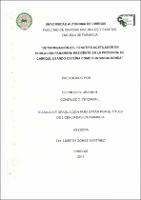Mostrar el registro sencillo del ítem
Determinación del fenotipo acetilador en población panameña residente en la provincia de Chiriquí, usando cafeína como sustancia sonda.
| dc.contributor.author | Espinoza N, Urania H | |
| dc.contributor.author | González C., Yetzania L. | |
| dc.date.accessioned | 2023-11-16T15:44:36Z | |
| dc.date.available | 2023-11-16T15:44:36Z | |
| dc.date.issued | 2015 | |
| dc.identifier.uri | http://jadimike.unachi.ac.pa/handle/123456789/1024 | |
| dc.description.abstract | La N-acetylación es un paso metabólico catalizado por N-acelli-transferasas. Que intervienen en la transferencia del arupo acelio de la Acell Coenzima A al sustrato. La reacción ocurre en dos pasos secuenciales. Inicialmente la Aceti-Coenzima A se enlaza a la enzima y el grupo acetilo es transferido al sitio aclivo (residuo de cisteína; Cis° en el humano), liberándose la Coenzima A. En el segundo paso el grupo acetilo es transferido desde la enzima acetilada al grupo amino del sustrato con la regeneración de la enzima. La enzima NAT2 puede activar o inactivar aminas carcinogénicas, aromáticas o heterocíclicas y xenobióticos dependiendo del tipo de acetilación: O acetilación que por lo general activa carcinógenos ambientales y N-acetilación que se considera que los inactiva. Los polimorfismos en este gen pueden afectar la susceptibilidad individual a estos compuestos. Dependiendo del tipo acetilador lento o rápido, un individuo puede estar predispuesto a cáncer de colon, pulmón, vejiga, cabeza, cuello y mama, y algunas enfermedades como el asma, Parkinson, Alzheimer, entre otros. Esto también afecta la efectividad de algunos fármacos y la toxicidad de diversos cenobíticos. Objetivo: Caracterización del fenotipo acetilador de la población chiricana. Este conocimiento puede contribuir en el establecimiento de posibles factores de riesgo de esta población, a la exposición de algunos fármacos y contaminantes ambientales y a la predisposición a ciertos tipos de patologías. Metodología: Se determinó el fenotipo acetilador utilizando cafeína como sustancia sonda. Se tomó una muestra representativa de 52 individuos a los cuales se analizaron mediante una técnica por HPLC la eliminación urinaria de los metabolitos AFMU 1-MX. La actividad de AFMU se determinó en base a la razón molar AFMU/1-MX de estos dos metabolitos Resultados: Se observó una distribución bimodal que permite clasificar a la población estudiada en un 67 por ciento de aseladores rápidos y 33% de acetiadores lentos. Conclusión: Estos resultados son cercanamente coincidentes con los reportados previamente por Arias, et al.. (2002), en población indígena chiricana y en otras poblaciones de Centroamérica Palabras claves: Acetilador, fenotipo, cafeína, genes, farmacogenética. | es_ES |
| dc.description.abstract | -acetylation is a metabolic pattway catalyzed by n-acetyitransferases. These enzymes intervene in the transference of the acelyl group of acetyl-CoA to a substrate The reaction occurs in two sequential steps list, acetic binds the engyme, and the acetyl group is transferred to the active site (a residue of cysteine, Cis in humans), and acety+CoA is liberated. Then, the acely group is transferred from the acetylated enzyme to the amine group of the substrate with the regeneration of the enzyme. The enzyme NAT2 can activate or inactivate carcinogenic aromatic amines or heterocyclic compounds and xenobiotics depending on the type of acetylation: O-acetylation is associated with the activation of environmental carcinogens, and N-acetylation inactivates them. The polymorphisms of this gene can affect the individual susceptibilty of the compounds. Determined by the acetylator, whether fast or slow, the individual might be predisposed to various types of cancer like colon, lungs, bladder, brain, neck, or mammary. and illnesses like asthma, Parkinson's, Alzheimer's, etc. The effectiveness of drugs and the toxicity of certain xenobiotics is also affected. Objective: To characterize the acetylator phenotype of the population of the Chiriqui Province. This knowledge can contribute to establishing risk factors for the population when exposed to certain drugs, environmental pollution, and their predisposition to illnesses. Methodology: The acetylator phenotype was determined using caffeine as a metabolic probe. A representative sample of 52 individuals was analyzed by employing the technique of high-performance liquid chromatography (HPLC) of the urinary elimination of the AFMU 1-MX. The activity of the AFMU was established based on the molar ratio 1FMU/1-MX. Rosults: A bimodal distribution was observed, which allowed us to classify 67% of the individuals as fast acetylators and 33% as slow acetylators. Conclusion: These results are closely matched with the ones reported previously by Arias el al. (2002) in the indigenous population of Chiqul Province and other populations of Central America. Keywords: Acetylator, phenotype, caffeine, gene, pharmacogenetic. | |
| dc.language.iso | es | es_ES |
| dc.publisher | Universidad Autónoma de Chiriquí | es_ES |
| dc.subject | TÉSIS -- FARMACIA | es_ES |
| dc.subject | GENOTIPO | es_ES |
| dc.subject | BIOLOGÍA DE POBLACIÓN -- PANAMÁ | es_ES |
| dc.subject | RAZAS -- PANAMÁ | es_ES |
| dc.subject | FENOTIPO | es_ES |
| dc.title | Determinación del fenotipo acetilador en población panameña residente en la provincia de Chiriquí, usando cafeína como sustancia sonda. | es_ES |
| dc.type | Thesis | es_ES |
Ficheros en el ítem
Este ítem aparece en la(s) siguiente(s) colección(ones)
-
Licenciatura en Farmacia
Tesis de la escuela de Farmacia.

